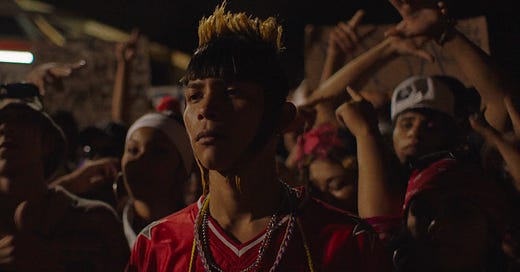I have been thinking about displacement a lot lately. It is a constant thread in the world around us and at the heart of so many news stories. Some of us are lucky enough to choose where we ‘dis’place ourselves; others have no choice. Displacement isn’t always a literal move; it can also show up in the simple act of growing up.
This quiet, complex experience of growing up, identity, and loss sits at the centre of a film I find near perfect: Ya no estoy aquí. If you have not seen this film yet, take note - find it and watch it.
Ulises (17) lives in the poorer district of Monterrey, Mexico, and he is a leader of a gang called Los Terkos (The Stubborn). Los Terkos are avid followers of a counterculture movement called Kolombia, based in music (like teenagers all over the world, since teenagers became a thing). They listen to cumbia rebajada, dress in baggy clothes, and sport wild hairstyles, all in service of the performative act of dancing.
Ulises is pulled into a gang war and is forced into exile in the USA. His separation from everything he knows and understands is the journey we watch him venture through. The film moves between Monterrey and New York, showing Ulises’ attempts to adjust to his new reality.
Ya no estoy aquí is a film about exile, it explores the ephemeral state of being and how time and place shift continuously as we grow. It also challenges how much of your identity is tied to external factors.
Key Themes
Cultural identity & belonging
Ulises' struggle reflects how forced displacement affects personal identity and the difficulty of assimilating into a foreign environment.
Music as a cultural anchor
The Kolombia movement is a unique hybrid of cumbia music, slow dancing, and street fashion, acting as a form of resistance and self-expression.
Classroom Discussion
Exploring specific film elements as links to cultural context.
Getting students to look at specific choices in a film can guide them towards unpacking a deeper interpretation that links them to authentic intentions and meanings.
I chose three main ideas to focus on for this post: music as a form of cultural heritage, clothing as a marker of belonging, and the idea of forced migration.
Music as cultural heritage
Ulises’ identity is built on cumbia rebajada, a slowed-down version of Colombian cumbia music, remixed by working-class youth in Monterrey. The music is more than a soundtrack, it is his cultural home.
How does the film use cumbia rebajada to reflect Ulises' emotions?
What happens when Ulises’ music doesn’t translate in the U.S.?
What does this say about cultural displacement beyond physical migration?
Clothing as a marker of belonging
The oversized shirts, shaved sides, and long hair of the Kolombia aesthetic are hyper-specific. They signal belonging within a marginalized group while marking them as outsiders to the rest of society.
Ulises is secure in his identity until he is displaced in the United States, where no shared reference point to identify him exists. People do not understand who or what he is because his cultural knowledge is personal to his time and place; it is not a shared context.
How does fashion function as a symbol of identity in the film?
Compare the use of costume in Monterrey vs. New York. What shifts?
Can students think of other subcultures where clothing is both protective and alienating?
Forced migration
Many migration stories focus on economic struggle (an inherent factor), but what often gets missed is that much migration is not a choice but a necessity.
Ya no estoy aquí uses gang violence as the context for the story told, but the film is also about identity and cultural loss. Ulises does not leave Mexico because he wants to; he is forced out. His desire to return is about returning to what is familiar, to community, to his assured identity, and thus, to himself.
How does the film challenge traditional migration narratives?
How does it use flashbacks to emphasize nostalgia and loss?
Ya no estoy aquí highlights cultural loss and nostalgia. It is a deeply atmospheric and poignant film about a young man whose identity is tied to a community (and time) that no longer exists when he returns.







